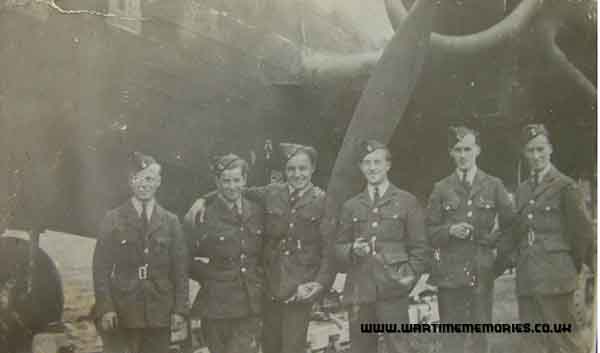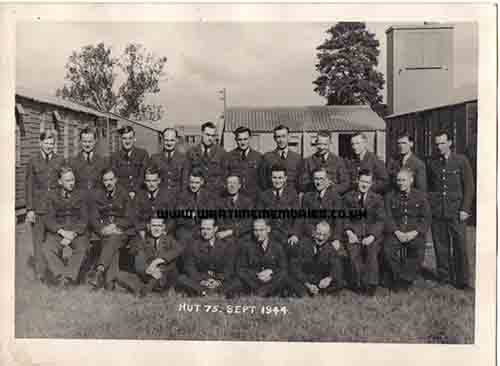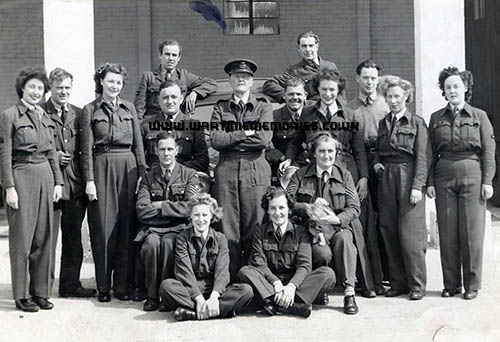|
|
|
RAF Honeybourne
 Honeybourne Airfield opened on the 3rd of December 1940 and was used for training Canadian pilots.
The Airfield closed in 1947. The runways have now reverted to farm land and part of the site is now an industrial park. The control tower is now a private dwelling.
 Hanger at Honeybourne, now used as an industrial unit.
17th Nov 1944 Aircraft Lost
If you can provide any additional information, please add it here.
|
Those known to have served at RAF Honeybourne during the Second World War 1939-1945. - Barnard Ronald William. Cpl.
- Bedford. E. L. . P/O
- Bell Theodore.
- Bell. Theodore .
- Bennett Veronica F.. LACW.
- Bradbury Robert Thomas.
- Brennan. Irene .
- Dwyer. . F/S
- Garland Victor Alan. Fl/Sgt.
- Gibson Stuart Paul .
- Goodwin David Webster. F/Lt. (d.20th May 1944)
- Hamer Annie Rothwell. Cpl.
- Hill Pat.
- Irving Betty.
- James. W. M. . Sgt
- Johns DFC.. Stephen Joshua. F/Lt.
- Kershaw MID. James Christopher. LAC
- King. . S/Ldr
- Lapham W. G.W. . P/O
- McBride Dillis.
- McLeod Donald .
- Owen. A. E.. Sgt.
- Preston J. A. . P/O.
- Rance Tommy.
- Robertson C. R. . Sergeant
- Russell. . F/O
- Scrivens. . F/O
- Sharpe Robin.
- Smith Victor Eugene.
- Turgoose . Ernest .
- Wade. George . P/O
- Ward. . F/S
- wigley harold stanley.
- Wilde. . Sgt
The names on this list have been submitted by relatives, friends, neighbours and others who wish to remember them, if you have any names to add or any recollections or photos of those listed,
please
Add a Name to this List
|
|
|
The Wartime Memories Project is the original WW1 and WW2 commemoration website.
Announcements

- 1st of September 2024 marks 25 years since the launch of the Wartime Memories Project. Thanks to everyone who has supported us over this time.
- The Wartime Memories Project has been running for 25 years. If you would like to support us, a donation, no matter how small, would be much appreciated, annually we need to raise enough funds to pay for our web hosting and admin or this site will vanish from the web.
- 19th Nov 2024 - Please note we currently have a huge backlog of submitted material, our volunteers are working through this as quickly as possible and all names, stories and photos will be added to the site. If you have already submitted a story to the site and your UID reference number is higher than
264989 your information is still in the queue, please do not resubmit, we are working through them as quickly as possible.
- Looking for help with Family History Research?
Please read our Family History FAQs
- The free to access section of The Wartime Memories Project website is run by volunteers and funded by donations from our visitors. If the information here has been helpful or you have enjoyed reaching the stories please conside making a donation, no matter how small, would be much appreciated, annually we need to raise enough funds to pay for our web hosting or this site will vanish from the web.
If you enjoy this site
please consider making a donation.
Want to find out more about your relative's service? Want to know what life was like during the War? Our
Library contains an ever growing number diary entries, personal letters and other documents, most transcribed into plain text. |
|
Wanted: Digital copies of Group photographs, Scrapbooks, Autograph books, photo albums, newspaper clippings, letters, postcards and ephemera relating to WW2. We would like to obtain digital copies of any documents or photographs relating to WW2 you may have at home. If you have any unwanted
photographs, documents or items from the First or Second World War, please do not destroy them.
The Wartime Memories Project will give them a good home and ensure that they are used for educational purposes. Please get in touch for the postal address, do not sent them to our PO Box as packages are not accepted.
World War 1 One ww1 wwII second 1939 1945 battalion
Did you know? We also have a section on The Great War. and a
Timecapsule to preserve stories from other conflicts for future generations.
|
|
Want to know more about RAF Honeybourne? There are:2 items tagged RAF Honeybourne available in our Library There are:2 items tagged RAF Honeybourne available in our Library 
These include information on officers, regimental histories, letters, diary entries, personal accounts and information about actions during the Second World War. |
|
Ernest Turgoose 626 Sqd. My wife's late grandfather, Ernie Turgoose, volunteered and entered the RAF in 1939/40, aged approx 35. He was in Groundcrew throughout WW2, in the UK. I believe he ended the war at Wickenby, I saw his squadron photo taken in front of a Lanc, which I believe was shot there when was he with 626 Squadron. My wife recalls him saying he was also at Honiley (Warwickshire) which is our 'local' airfield. He may also have been at Honeybourne (Worcs). Does anyone remember him or know anything more about his service?
|
harold stanley wigley 24/O.T.U I am looking at my fathers' log book dated from 20th Feb 43 - 10th Oct 45.
his squadron # 192 was on a 30 year secrecy, which of course has now expired.
The entries for Honeybourne
date aircraft pilot duty
12.3.43 s whitley f/lt. thomas air gunner
13.3.43 x whitley sgt cass air gunner
13.3.43 q whitley f/lt thomas air gunner
14.3.43 p whitley s/l king air gunner
18.3.43 r whitley f/lt thomas air gunner
21.3.43 r whitley f/lt thomas air gunner
22.3.43 s whitley sgt cass air gunner
If you have any further information on this squadron and my fathers' stay would be appreciated.
I do have a photo of his crew members if you are interested.
Thank you for your time.
|
F/Lt. Stephen Joshua "Johnnie" Johns DFC. 115 Squadron My father, Flight Lieutenant Johns DFC, flew 30 sorties with 115 Squadron in 1941/1942 as an air gunner including first 1000 bomber raid on Cologne. He transferred to Honeybourne as a gunnery instructor then in 1943 to SOE and 161 squadron based in Tempsford, flying 22 secret missions into France, Norway, Denmark etc.
|
LACW. Veronica F. "Candy" Bennett 24 OTU I arrived at 24 OTU, Honeybourne soon after D Day in June 1944. I soon found myself working on the engines of my favourite aircraft, Vickers Wellington Mk.II. along with two or three other WAAF Mechanics. We were not very well liked by the RAF mechs, I believe they were a bit jealous of the attention we received from the aircrew (the Brylcream boys). Once we and the other technical ground crew had completed their servicing of the engine and re-installed it in the aircraft, it was necessary to do a test run, then a test flight. On several occasions I went along on these test flights. As I was quite small and still very young, I took a lot of teasing from both the ground and aircrew, and many times they would pull some crazy stunt to try and scare me, but I actually enjoyed it and felt no fear. It was a dirty job, but someone had to do it.
I was at Honeybourne for the better part of a year and being the only Canadian female among so many Canadians I was invited to the shows and special events awarded the RCAF personnel. A few years ago I was living in Florida and attended a luncheon put on by The Evaders (airmen shot down who escaped capture), and was surprised to meet three former aircrew who had been stationed at Honeybourne. Also, on 1st April, 2014 I attended the 90th Anniversary of the RCAF at Government House here in Victoria with my husband, Wing Commander Ronald Butcher DFC.,and met up with a gentleman who had been stationed at Wellesbourne, the satellite to Honeybourne. It really is a small world after all.
IHave always wanted to find another WAAF aircraft engine mechanic, and if there is one reading this, I would love to hear from you.
I now live in beautiful Victoria, British Columbia,and enjoy a monthly re-union lunch with a few ex-WAAF. We each have a story to tell and mine is in my book "From WAIF to WAAF to WIFE" which I wrote in 2002.
|
P/O E. L. Bedford. 24 Operation Training Unit I am researching the Roll of Honour for my old school and one casualty was Pilot Officer E.L. Bedford. He took off from Honeybourne in a Whitley bomber belonging to 24 Operations Training Unit (OTU) on 24/25 June 1942 heading for Bremen. OTU s very often flew in missions with a/c crewed by trained crews. The Whitley was a Mk V serial number Z 9441. The rest of the crew were: Pilot Officer J.A. Preston RCAF, Pilot Officer W.G.W. Lapham and Sergeants C.R. Robertson RCAF and A.E.Owen. Any information please?
|
Theodore Bell. My friend Tanina is searching for her grandad, who was based in Honeybourne in the 40s. His name we beleive is/was Theodore Bell. He was an Amercian G.I. Had had a relationship with Tania`s nan, Anne Lloyd/Smith and they had a son Roger in 1945. Theodore knew of his son and returned from states when his son was about one year old. I was just wondering if anyone had any pictures of the troops around then. Any information would be a start.
|
F/Lt. David Webster Goodwin 24 Operation Training Unit (d.20th May 1944) A Whitley from Honeybourne was shot down by dca in my area, Orne Normandy on 23rd of May 1944. The pilot was F L Goodwin. All the RCAF crew disappeared in the crash and we will erect a monument in 2005 due to the fact the crash has been discovered only in 1998 by myself after a long investigation. There were only 2 witnesses.
|
P/O George "Geordie " Wade. 24 Operation Training Unit I Flew With The Canadians
I was called up into the RAF from Durham University Air Squadron on 9th May 1942 as an aircrew trainee aged 19½ years of age, and spent three weeks of induction at ACRC London living in Avenue Close, St John’s Wood. There followed three weeks in the Metropole Hotel in Brighton before posting to No 9 EFTS, Ansty, Warwickshire for the aircrew grading course. This involved 12 hours dual instruction in DH82A “Tiger Moth” aircraft in which we did “the whole business” of flying, up to spins and recovery from spin. I absolutely loved it but I failed to go solo.
From there we went to Heaton Park, Manchester where we lived in small ridge tents awaiting our new gradings. I was to become a Bomb Aimer (officially Air Bomber).
After seven weeks, many of us were sent to Marine Court, St Leonards on Sea (9½ hours by train) to wait for posting to training units. I was on the 12th floor and lifts were not operating! I became very fit going up and down the stairs several times a day for four weeks.
The building was attacked twice by cross-channel Me109 and FW190 fighter bombers and on the second occasion it was slightly damaged, so we went back to Heaton Park via Harrogate (9 hours). One week later we travelled to Gourock (10 hours by train) to board RMS Queen Mary. There were 18 to a cabin and only 2 meals a day. These were meals like pre-war food because these troopships stocked up in the USA. We had actual white bread (unlike the National Loaf at home) and sausages with meat in them!
On board we could buy plenty of Coke and chocolate and cigarettes were 2/6d for 200. After landing at Boston, Mass, we took the train up to Moncton, NB through the brilliant autumn colours of New England. 4 days later it was a CNR train journey across Canada via Lake Superior and the prairies to No 5 Bombing and Gunnery School at Dafoe, Sask. On completing that course we were posted to No 1 Central Navigation School at Rivers, Manitoba on New Year’s Eve 1942. There we did cross-country flights (map reading and bombing for me) in temperatures at night as low as -40ºC. The engines of the Avro Ansons had to have their oil diluted with petrol to facilitate starting in those freezing conditions.
There were individual ice crystals falling from the sky and the Northern Lights were spectacular. Completion of that course saw us on Wings parade and promoted to Sergeant. Then it was CPR train back to Moncton with a stopover at Montreal. At Moncton I was promoted to Pilot Officer and given $180 for kitting out (at T. Eaton Co). Soon afterwards it was train down to New York to board RMS Queen Elizabeth for the trip back to the Clyde. This time the cabin accommodation was the same as on the trip out but being an officer, I had meals in the first class saloon served by stewards. Both trips across the Atlantic were by Southern latitudes to avoid the U-boat packs in the North.
Back in the UK there was more bombing, gunnery, astro-navigation, map reading and signals at No 1 (O) AFU at Wigtown near Newton Stewart in the South West of Scotland. Then more of the same at No 24 OTU at Honeybourne, Gloucestershire where crews were formed.
I crewed up with Sgt RC Reinelt (Pilot), Sgt “Johnny” ARW Hardes (Nav), Sgt DH Williams (W/Op A/G) and RCAF Sgt G Dykes (A/G). After that it was a move to 6 Group RCAF, starting at 1659 Heavy Conversion Unit at Topcliffe where we trained on old MKI Halifaxes and on 16th September 1943, I celebrated my 21st birthday. We went on to RCAF Squadron 429 at Leeming having picked up a F/Eng Sgt JE Peppercorn and a mid-upper gunner RCAF Sgt “Curly” Shields making a crew of seven.
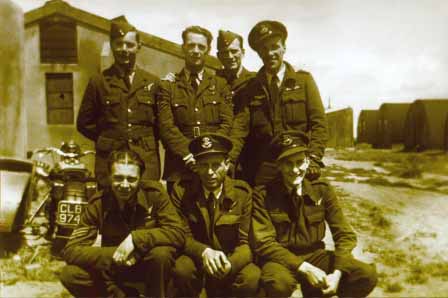
Crew of Q Queenie at Skipton on Swale, 433 Squadron April 1944
Back Row Left to Right:
Sgt DE Carruthers, M-U Gunner RCAF.
Sgt DH Williams, W/Op A/G RAF.
Sgt ARW Hardes, Nav RAF.
P/O RC Reinelt, pilot RAF.
Front Row Left to Rig:
Sgt JE Peppercorn, FL Eng RAF.
P/O G Dykes, Rear Gunner RCAF.
F/O GM Wade, Bomb Aimer RAF.
At 429 Squadron (Motto : FORTUNAE NIHIL – nothing to chance) led by W/Cdr Patterson DFC (known to us as “2650 + 4” because of his insistence on such revs and boost for economical cruising), we flew Halifax MK II’s. Although we were based at Leeming we actually flew from Skipton-on-Swale.
When we, as a crew, had done four ops we were posted to Skipton as part of the nucleus of five crews to start 433 Squadron (Motto : QUI S’Y FROTTE S’Y PIQUE” = whoever rubs himself there will be pricked there) – the Porcupine Squadron. One crew piloted by RCAF P/O Chris Nielsen (nicknamed “the mad Dane”) had done 15 ops and so were very experienced.
At Skipton we flew Halifax Mk III’s under the leadership of W/C Clive Sinton DFS, a superb CO, and the aircraft were totally trustworthy and good performers. In a tragic accident in late December 1943 an aircraft piloted by F/O PR Humphries was taking off at Skipton and crashed on to our aircraft which was parked at dispersal. The five crew members and two ground crew members were all killed and both planes were destroyed in the resulting blaze. Since I was the only officer in our crew at the time, I was appointed officer in charge of the escort party at the funeral of these seven men. The funeral took place in Harrogate on Christmas Eve which was a very frosty day. It was a truly miserable occasion. I cannot imagine what was put in the coffins since both planes were reduced to ashes. Normally each carried 1800 gallons of petrol plus ammunition for the guns, and some flares.
I trained on H2S and Gee, while the Squadron was expanding, and my task apart from bombing was to take and log fixes every two minutes when possible, sitting alongside the navigator. I assisted the pilot with engine controls on take off and landing and took over from him occasionally especially on training flights and returns from operations. I was also expected to be emergency pilot as well as deputising for other crew members, should the need arise.
At an early stage at 433 Squadron “Curly” Shields went back to Canada and we were joined by RCAF Sgt Doug Carruthers as Mid-Upper Gunner. Three of the five crews who formed the nucleus of 433 Squadron were soon lost on ops leaving Chris Nielsen’s crew and ours. Sadly Chris and his crew were shot down just short of the target on their 27th op. and at least one of the crew, F/Eng P/O Christopher Panton, was killed. This was the disastrous raid on Nuremberg (30th/31st March 1944) when 95 aircraft were lost. It was nearly 96 because we were attacked by a Me210 just after leaving the target. We lost an engine and two fuel tanks when we were hit by 3 cannon shells which resulted in a fire in the wing. We were able to make the trip back to Englnd landing at Manston in Kent. This was our 15th operation.
The skipper was commissioned and received an immediate DFC. The rest of the crew were commissioned later and then the Navigator and both Gunners received DFC’s.
Almost half of our raids lasted between 6 and 8¼ hours and the rest were from about 3 to 6 hours. After D-day most operations were daylight ops to Northern France. The sky seemed full of aircraft all around, which we had not been aware of in the dark.
Instead of the full 30 ops for a tour, I was allowed to finish on 29 having been in Station Sick Quarters (when the rest of the crew went to Berlin) because of a very bad cold! This was not really surprising seeing that we lived in cold Nissen huts, the crudest accommodation we could have had, other than tents.
Incidentally, Chris Nielsen’s F/Eng Christopher Panton, who was killed, has been commemorated by the establishment of the Lincolnshire Aviation Heritage Centre by his two younger brothers, near Spilsby, Lincolnshire.
Also it may not be well known that only one crew out of three completed a tour of 30 ops without being shot down or lost in some other way.
Having completed my tour in June 1944 I was posted to a number of OTU’s as bombing instructor then went on to BDU, Feltwell and CBE Marham in Norfolk. Marham was the last of my active service stations before demob in August 1946. I went back to University to finish my degree in Electrical Engineering, extremely relieved to have survived my time in the RAF and glad to have flown with the Canadians.
|
Robert Thomas Bradbury 115 Squadron My Dad, Robert Thomas Bradbury, served as an engineer with Bomber Command in 115 Squadron. He did his initial training at Cardington. He is second left on this picture which was taken at Marham in 1940. He transferred to Honeybourne at the end of 1941 and to Honley in 1943. The second picture was taken there and Dad is in the centre of the back row. It is labelled MU Honley 1944/45
|
Betty Irving Balloon Ops I served with the WAAF in WWII on balloon ops at Honeybourne Camp. Is Eddie Edwards still around? Still think of you.
|
Victor Eugene Smith Victor Smith served with the Royal Air Force at RAF Honeybourne.
|
LAC James Christopher Kershaw MID RAF Honeybourne 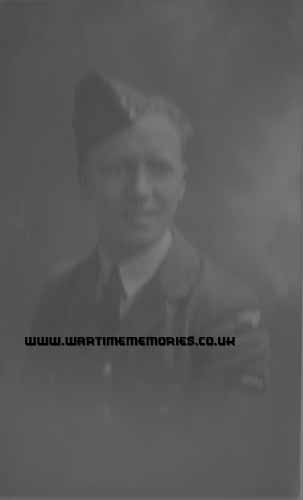    As a young man who applied for service during World War II, James Kershaw found himself in the Royal Air Force Volunteer Reserve under the Officer Commanding RAF Station Honeybourne, Worcester as a member of the fire crew. He was born on 20th October 1920, which puts him in his twenties during his service years.
As far as I know, their job was to prepare the aircraft for its outward journey and its somewhat precarious return after a sortie. I remember James (my dad) telling me about how the planes had often been shot to pieces and it was miraculous that some of them got back. Some that did make it thus far would have damaged landing gear and it was the job of the fire crew to get the pilot and other airmen out of the plane on landing as soon as possible.
An account of what happened is written by Air Chief Marshall A.T. Harris KCB, OBE, AFC and I have a framed copy of this letter:
Air Chief Marshall A.T. Harris KCB, OBE, AFC
A.124
The Commander-in-Chief wishes to bring to the notice of all ranks in the Command, the courage and devotion to duty displayed by the under mentioned airmen of R.A.F. Station, Honeybourne:
- 1669210 LAC Leighs, W.S.
- 1313399 AC1 Herritage, S.G.
- 1161330 LAC Hancock, A.
- 1505750 AC1 Fennell, J.A.
- 1143912 LAC Kershaw, J.
- 1689333 AC1 Hodgson, S.W.
- 3011580 AC2 Ealeson, R.
- 1421278 LAC Taylor, L.F.E.
On the night of 3rd/4th July 1944, an aircraft apparently stalled on coming into land, crashed into the bomb dump and burst into flames. The fire which started ignited a large number of explosive incendiary bombs. The above mentioned airmen, who together constituted the duty and stand-by fire tender crews, proceeded immediately to the scene of the crash and under the direction of the Fire Officer and of the NCO in charge of the fire party, tackled the fire which by then had assumed serious proportions. Despite the intense heat arising from the combination of blazing petrol and explosive phosphorus bombs, and the serious risk of explosion from the presence of high explosive bombs in the dump, the crew continued to fight the fire from close range without any form of protection and with complete disregard for their own personal safety. So successful were their efforts, that within one and a half hours the fire was completely extinguished and all danger of the remainder of the dump becoming ignited was removed; had the fire not been so promptly and thoroughly checked, there would not only have been extensive loss of government property, but also a possibility of loss of life.
Although the crew of the aircraft were killed almost instantaneously, and it was not possible to recover any of the bodies, it is considered that all members of the Fire Tender crew displayed a high standard of courage and devotion to duty as well as a complete disregard for their own safety in circumstances of great difficulty and danger.
BC/23054/P.
I also have in a frame which reads:
By the Kings Order the name of Leading Aircraftman J. Kershaw, Royal Air Force Volunteer Reserve,was published in the London Gazette on
1st January 1945 as mentioned in a Despatch for distinguished service. I am charged to record His Majestys high appreciation.
Signed by Secretary of State for Air.
In addition I have in a frame an embossed letter from RAF Station Honeybourne:
Royal air Force Station, Honeybourne, Evesham, Worcs
Ref: HB/C.70010.
Dear Kershaw,
I am attaching a copy of a Command Routing Order which has been received on the unit.
It is the Commander-in Chiefs wish that you should have a copy of this Order as a record of your courage and devotion to duty.
My heartiest congratulations to you as well as my sincere thanks for your valiant efforts.
Yours sincerely,
Group Captain, Commanding,
RAF Station Honeybourne
No.1143912 LAC. Kershaw, J, RAF Station Honeybourne, Worcs.
And here is the copy of the above mentioned letter:
From: Officer Commanding, RAF Station, Honeybourne, Worcs.
To: LAC J. Kershaw, RAF Honeybourne.
Date: 8th January 1945
Ref: HB/C.70010/3.
Honours and Awards.
Your name appeared in the New Years Honours List as having been Mentioned in Despatches by the Air Officer Commanding-in-Chief Bomber Command.
The Air Officer Commanding No. 91 Group wishes his best congratulations conveyed to you, on this well deserved recognition of your service.
I would like to associate myself with the remarks of the AOC No. 91 Group.
Signed Group Captain, Commanding, RAF Station, Honeybourne.
My dad, James, seldom spoke about the duties he performed during the war years but he did occasionally mention the horrendous injuries of airmen returning from their sorties as we gathered around the TV watching war films.
I remember dad, watching the parades of servicemen and women passing the Cenotaph in London in November on the TV remarking on how the uniform of the Air Force personnel was always the smartest.
I am very proud of my dad.
|
Fl/Sgt. Victor Alan Garland 429 Bison Squadron Victor Garland joined up in 1943 to Royal Air Force, trained in St Athans, Wales then transferred to a Canadian squadron, 429 Bison Squadron stationed in Leeming, Yorkshire.
The other Crew members were all Canadian: -
Pilot Officer Doug Williams,
-
Wireless operator, Don Schurman,
-
Navigator, Wesley Milne,
-
Bomb, Aimer Jack Horner.
He initially flew Halifaxes as Flight Engineer, then went through the Heavy Conversion Unit at Wombleton or Honeybourne and was then flying Lancasters. After VE day the Canadians left and Victor was involved in bomb dispersal in the North Sea and repatriation of Prisoners of War from Belgium. He met and married Emilia Occardi, a Waaf who served on station alongside her twin Marie. He died in 2006.
|
Cpl. Ronald William Barnard 91 Operational Training Unit My late father, Ronald Barnard, served with No. 91 OTU Bomber Command at Wellesbourne Mountfield, Warwicks, I have a photo of Hut 75 in September 1944. He was on the clerical side.
He was also stationed at RAF Honeybourne at some time during the War.
|
Cpl. Annie Rothwell Hamer Anne Hamer moved to Honeybourne where a Canadian air crew were based. Here they had to have bikes and had to travel a few miles to mess. She was a driver and the role was taking crews to get their parachute, to the control tower, then to dispersal point, and then this sequence in reverse. These were long twelve hour days. She was stationed here when the war finished in 1945.
At Honeybourne there were always plane crashes due to the fact that it was in a valley and the planes used to crash into the trees on the hills. Anne had to go out to one where there were bodies in the trees, they used to know all the men because they would take them out to all the planes.
|
Recomended Reading.Available at discounted prices.
|
Angry Skies Across The ValeBrian Kedward
An authentic day-to-day record of the events that took place on the RAF Airfields at Honeybourne and Long Marston.
|
|
|








